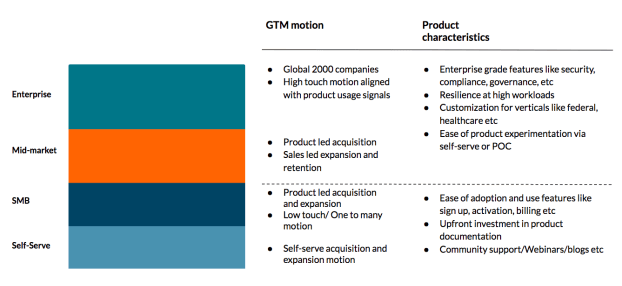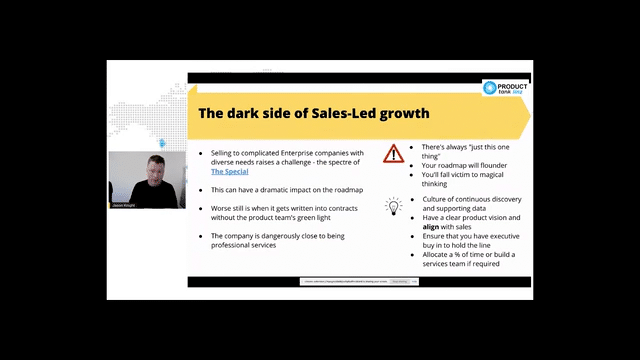B2B product management is different from B2C. For starters, you’re not selling directly to consumers and so who your customer is exactly can get a bit tangled. In this two-part series, we speak to three seasoned B2B product people, working in different industries, to learn what they love about product management in a business-to-business environment, how it differs from B2C, their biggest challenges, and any advice they have for other B2B product people.
In brief
- The cadence may be different from B2C but the pressures and challenges are no less intense.
- You typically have fewer customers and your customers may well not be your users, but you need to show both groups the value of continuing to use your product.
- There can be a wide range of sophistication among your customer base, and your product must solve different problems for different customers.
- It’s not always easy to speak to customers. You should talk to them as often as you can, and build strong relationships with the teams that speak to them regularly like customer service and sales. Make sure these teams have the right tools and training to be your proxy.
Product management in EdTech
Lori Edwards, Senior Product Manager at Niche.com
Niche.com is a US platform that connects students with schools and universities to help them find the institution that fits them best. It started as a book publishing company in 2002, producing guides to Ivy League schools. It moved into digital four years ago and last year completed Series B funding to continue its digital expansion. Lori has been there for about a year, previously working for another edtech business.
Niche.com’s customers are US schools and colleges who pay to use the platform to connect with prospective students, says Lori. “For students our site is always free to students don’t pay to use our website. They can come into the site, search, compare schools, and find out information like what it’s really like there and what they need to enrol in school.”
The company acts as a middle man between school and student – Lori describes it as a B2B2C model because the business has direct contact with students and provides them with the tools they need to decide which school they want to attend — but its revenue comes from schools.
Students can create a profile online and they can control which schools they share their data with. Niche.com collects a variety of demographic information about them, their high school, subject and other interests, and so on. The platform contains information on schools like rankings, information for students like application costs, deadlines SAT and ACT requirements, and reviews by students attending the school. Lori says Niche.com is looking to develop a feeling of community and build a two-sided marketplace: “Similar to LinkedIn, where employers can talk to employees, you can make connections and you can share with others — that’s where we’re heading, we’re building a true community.”
More personas
“I love the challenges of B2B,” says Lori. “There’s usually more people or personas to understand. The person that’s buying your product, or writing the cheque for it, is often not the person using it, so you have an interesting dynamic and challenge. You have to show this person that it’s worth continuing to buy your product, and you’ve got to make using the product easy and simple for the person who uses it.”
Lori says that while she doesn’t have the problem of managing the demands of one big influential customer — a common problem in B2B product management — some of the larger schools have more money to spend. “There is a wide range of customer sophistication. Schools with larger budgets usually have sophisticated systems and technology, whereas in a smaller school there might be three people in an office with a spreadsheet. Stanford doesn’t need more students to apply to go to Stanford but smaller schools really need help to recruit students.”
Remember those other stakeholders
So Niche.com has to solve different problems for different schools. For small schools, the chief problem is awareness: “People don’t even know that these schools exist, never mind that you can get in there and they might even give you a full scholarship,” says Lori. “It’s our job to shift this lopsided marketplace into a more distributed marketplace, and for example, maybe instead of 2,000 people getting into five schools, we can get 20,000 people into 100 schools. Each year, Niche.com helps over a million students connect with schools and we look to keep growing that number.”
The biggest challenge is understanding that your buyer is not always your user. Product managers need to understand the goals of both buyers and users because they must be able to communicate their product’s value and ROI to buyers or risk getting cancelled when schools are going through their budgets.
She adds that it’s too easy to forget about other B2B stakeholders — you can be so focused on the user that you forget to consider the buyer or whether the tool is solving the problem for their management team. “They’re not clicking around in the tool so you’re not watching their user metrics,” she says. “In B2C product management, the consumer is the person using the product. You can see how they’re using your product. In the B2B market, it’s disjointed. Those people who are often your true decision makers don’t even go into the product. But you still have to find ways to connect with them and get them to understand their return on investment and how your product is helping them to reach their business goals.”
Love your sales team
Product managers are constantly advised to keep talking to their customers, but when your customer is not your user, how do you speak to them? Lori’s advice is to build relationships with your sales and account management teams. “These are the people that talk to the customers the most, and they typically get to talk to the cheque signers.”

Lori says she uses her sales team as a conduit to people in customer organisations. “I like to think of sales teams and account management teams as the voice of the product manager,” she says. “ They’re the ones preaching about your product, up-selling your product, the ones who are truly trying to share your vision and the mission of what you’re all trying to achieve as a product team, to your customers. By making sure that they’re equipped to do that, and that they have the right tools and training, they can be a great proxy for you.“
Find more B2B insights in Part 2
Next week (Wednesday, 15 December), we bring you even more B2B insights. Speaking with Jason Knight, Product Director at DueDil, and Steve Nuttall, Global Head of Product Development at Mintel, we discuss the relationship between sales and product in B2B, about being pushed towards project management rather than product management, and the tension between short-term targets and what’s right for the long-term success of the product.
If you have insights to share, we’d love to hear from you. Complete our quick form to let us know which product topics get you all fired up! We’ll add you to our contributor database and get in touch when we’re working on the topics that suit you best.







Comments
Join the community
Sign up for free to share your thoughts